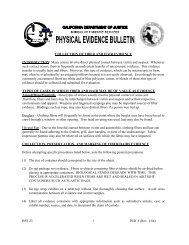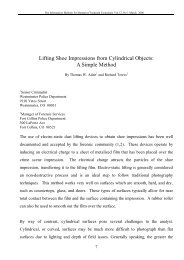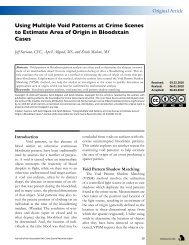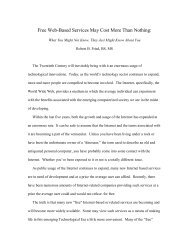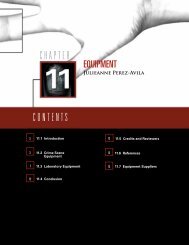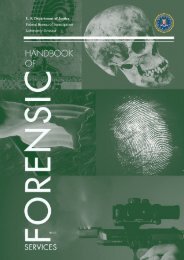PHYSICAL EVIDENCE MANUAL - Crime Scene Investigator Network
PHYSICAL EVIDENCE MANUAL - Crime Scene Investigator Network
PHYSICAL EVIDENCE MANUAL - Crime Scene Investigator Network
You also want an ePaper? Increase the reach of your titles
YUMPU automatically turns print PDFs into web optimized ePapers that Google loves.
Physical Evidence Manual<br />
17.0 PAINT <strong>EVIDENCE</strong><br />
Paints are used as surface coatings for a variety of surfaces such as vehicles,<br />
structures, and appliances. Many crimes, such as burglaries, hit and run vehicle<br />
investigations, and others involve forceful activities that can result in the transfer<br />
of paint from the original source to another place, person, or thing. Paints contain<br />
a multitude of components, many of which may be detected in very small<br />
samples such as those encountered as evidence. Analysis and comparison of<br />
paint samples can be successful even when they are extremely small in size.<br />
Paint examinations can determine:<br />
• Whether evidence paint sample(s) are similar to a paint standard<br />
• The type of paint (vehicle, architectural, etc.)<br />
• Possible make and model of a vehicle by using Paint Data Query (PDQ), a<br />
computerized database<br />
Collecting and Packaging Paint Evidence<br />
Be extremely careful collecting, packaging, and marking small paint chips. Small<br />
samples can be retrieved with forceps or tweezers and placed into a small<br />
paperfold or into a glassine envelope. If using a glassine envelope, take care in<br />
sealing the corners with tape to prevent loss of sample.<br />
• Do not lift or stick small paint particles onto adhesive tape. It is sometimes<br />
not possible to remove small particles from tape adhesive.<br />
• Do not place small paint particles in a paper envelope unless protected in<br />
a paperfold.<br />
When paint is smeared onto large or immovable objects, the paint should be<br />
scraped in such a manner as to collect as much of the smear as possible. These<br />
scrapings should be collected in a paperfold and properly labeled.<br />
In a situation where paint is smeared onto smaller or moveable objects e.g.,<br />
prying tools, protect the smear by loosely applying a cover and placing the entire<br />
object into an appropriate container.<br />
Collection of Standards<br />
If the object believed to be the source of the paint can be transported, submit the<br />
entire object to the laboratory.<br />
For objects or vehicles that are not easily submitted to the laboratory, collect<br />
standards from an area as close to the damage as possible. If a damaged<br />
vehicle is suspect, collect the paint standard from the edges of all damaged<br />
Adopted: May 2002<br />
Revisions: 6<br />
Last Revision: January 31, 2008<br />
17-1



